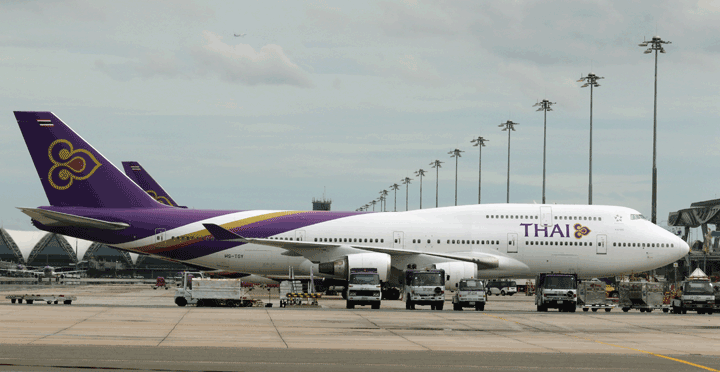 Slowing
Chinese and Thai economic growth and weak global demand for
Asian exports are seeing faltering air freight demand from Thailand. Slowing
Chinese and Thai economic growth and weak global demand for
Asian exports are seeing faltering air freight demand from Thailand.
 Stewart
Sinclair, senior vice president Asia and managing director of
Bangkok Flight Services, a leading handler at Bangkok’s
Suvarnabhumi Airport, said BFS was expecting volumes to remain
largely in line with last year’s performance of 370,000
tons. Stewart
Sinclair, senior vice president Asia and managing director of
Bangkok Flight Services, a leading handler at Bangkok’s
Suvarnabhumi Airport, said BFS was expecting volumes to remain
largely in line with last year’s performance of 370,000
tons.
“It’s a combination
of the Thai economy, which is currently stalled, the Chinese
economic slowdown, which has seen exports from China fall to
under 6 percent, and the global malaise,” he said. “Markets
have been preoccupied with the effects of the Greek crisis on
the Eurozone and slow growth in the U.S. economy, too. At present
we don’t anticipate any near term change to this outlook.
“Exports are down about
4.6 percent year-on-year so none of the trade lanes or commodities
are doing well—it’s just an overall malaise. Last
year we had a good last quarter driven by the iPhone 6 launch
and the west coast port strikes, but this year nothing much
is happening.”
The weakening of the Thai Baht
against the greenbacks could further complicate projections
in the months ahead. “The weakening of the THB has been
recent, so the effects of this will not materialize for 3-6
months in the supply chain as this is how long it takes to change
decisions on sourcing,” he said. “It will perhaps
weigh heavier on Thai products against other regional exporters.
“There is also a bit of
‘wait and see’ to see as to what effect the ASEAN
[The Association of Southeast Asian Nations” Economic
Community) freer market has, come Jan 1st 2016, when it is due
to be launched.”

The downturn in rates on major
lanes to and from Asia has mainly taken its toll on BFS in the
shape of freighter operator volumes. “There is always
downward pressure on rates from our airline customers,”
added Sinclair. “Even with reduced cost of fuel it seems
there is a continual challenge to balance supply and demand
to attract a decent yield and this obviously has the airlines
looking at all of their costs and the viability of operations.
This is particularly true of the freighter operators and we
have seen a reduction by some carriers over the past three years.”
As for a traditional spike in
demand towards the end of the year, Sinclair was not hugely
optimistic. “As far as I
am aware there are no major tech product launches planned for
the second half, and without those it is difficult to see what
would drive a spike in the market… except for perhaps
another west coast port strike,” he said.
But despite the bearish outlook,
BFS has continued to invest in facilities at its South East
Asia hub. After previously investing
$8.5m over 2012-14 on new cargo handling and x-ray gear, upgrading
its ground fleet and installing vertical carousels for small
parcels, this year a further $3m is being spent on a new Automated
Storage and Retrieval System (ASRS) system.
“This comprises racking,
fast moving cranes and storage bins,” said Sinclair. “It
allows us to use the vertical height of the building to increase
our storage capacity, especially for imports, where they may
be left in the warehouse for 2-3 days before being collected.
“They are highly efficient
for increasing capacity and they also operate very quickly and
are automated. We just scan an AWB and within seconds the shipment
is delivered to the import collection area.”
SkyKing
|



